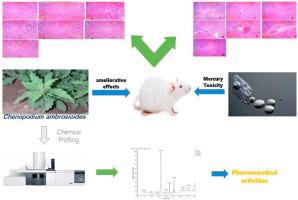Industrial Crops and Products ( IF 5.6 ) Pub Date : 2020-06-26 , DOI: 10.1016/j.indcrop.2020.112723 Gbenga S. Ogunleye , Oladapo F. Fagbohun , Olubunmi O. Babalola

|
Empirical literature reveals the use of Chenopodium ambrosioides var. ambrosioides leaf extract as antipyretic, antimicrobial, antioxidant, cancer chemoprotective, and antidiabetic agent in folklore medicine – with these pharmacological properties linked to its secondary metabolites. There are, however, no adequate information on the possible protective, regenerative, and ameliorative effects on toxicity induced by heavy metals. Hence, the investigations on mercury-induced nephrotoxicity and hepatotoxicity in this study. The leaf extract was profiled using gas chromatographic instrument coupled with mass spectrometer (GC–MS) and revealed 100 metabolites ranging from polyphenols, terpenes, terpenoids, and cardiac glycosides. The antioxidant assays revealed that C. ambrosioides leaf extracts possess antioxidant properties with hexane fraction exhibiting the highest scavenging activities for DPPH (IC50 = 0.02 mg/mL), FRAP (730.92 mg/AAE g), and metal ion chelating ability (IC50 = 3.18 mg/mL). Nephrotoxicity and hepatotoxicity biomarkers using total protein, albumin, total bilirubin, direct bilirubin, catalase, glutathione peroxidase (GPx), reduced glutathione (GSH), creatinine, uric acid, urea, ALT, and AST activities both in the kidney and liver homogenates of Wistar rats revealed significant regenerative improvement which differs significantly at p < 0.05 when compared with experimental rats with toxicant only. In the same vein, the histomorphological analysis showed remarkable hepatocellular regeneration presenting features of normal architectural arrangements of hepatic tissues while acute toxicological studies revealed that the LD50 of C. ambrosioides leaf material is well above 5000 mg/kg. The outcomes of this study showed that the leaf extract exhibited high hepatoprotective and nephroprotective activities as well as being implicated in the discovery of safe, cheaper, and effective therapeutic agents thereby highlighting its importance as a promising industrial crop.
中文翻译:

bro藜(Chenopodium ambrosioides var。ambrosioides叶子提取物具有抗汞诱导的肝毒性和肾毒性的再生和改善作用
经验文献表明使用了安息香藜(Cenopodium ambrosioides var)。ambrosioides叶提取物在民间传说医学中用作解热剂,抗微生物剂,抗氧化剂,癌症化学保护剂和抗糖尿病药-这些药理特性与其次生代谢产物有关。但是,关于重金属引起的毒性的可能的保护,再生和改善作用,目前尚无足够的资料。因此,在这项研究中有关汞诱导的肾毒性和肝毒性的研究。使用气相色谱仪结合质谱仪(GC-MS)对叶提取物进行分析,结果显示了100种代谢产物,包括多酚,萜烯,萜类化合物和强心苷。抗氧化剂测定表明C. ambrosioides叶片提取物具有抗氧化剂特性,己烷馏分对DPPH(IC 50 = 0.02 mg / mL),FRAP(730.92 mg / AAE g)和金属离子螯合能力(IC 50)表现出最高的清除活性= 3.18 mg / mL)。使用总蛋白,白蛋白,总胆红素,直接胆红素,过氧化氢酶,谷胱甘肽过氧化物酶(GPx),还原型谷胱甘肽(GSH),肌酐,尿酸,尿素,ALT和AST活性在肾脏和肝脏匀浆中使用的肾毒性和肝毒性生物标志物Wistar大鼠显示出明显的再生改善,与仅使用有毒物质的实验大鼠相比,p <0.05有显着差异。在同样,组织形态学分析显示出显着肝细胞再生呈现肝组织的正常建筑安排功能,同时急性毒理学研究表明,LD 50的土荆芥叶材料远高于5000 mg / kg。这项研究的结果表明,叶提取物具有很高的保肝和保肾活性,并且与发现安全,便宜和有效的治疗剂有关,从而突出了其作为有前途的工业作物的重要性。











































 京公网安备 11010802027423号
京公网安备 11010802027423号